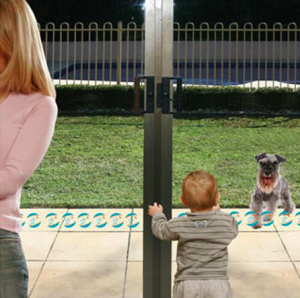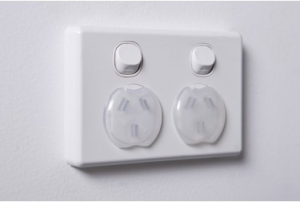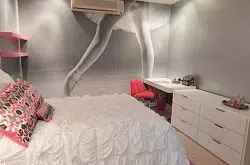There’s no keeping little kids from places they want to explore, and that’s especially true when they’re left to their own devices at home. Here, North Shore Mum Jessica Collins from BabySafe Products covers the best strategies to childproof your lounge room and bedroom in the second part of her safety series.
In our previous North Shore Mums article, I explained the basics of childproofing your kitchen and bathroom, as well as some simple solutions to making these areas a safer place to “be” for children.
This week, we guide you through some child safety ideas for the lounge and bedrooms. As we recommended, the best way to start is to get on your hands and knees and see the dangers your child could encounter, and then find some simple or creative solutions. Keep the following ideas in the back of your mind and some of those solutions will come easily to you!
Room-by-room: The Lounge
The lounge is often the focal point of the house, and the primary room for playing. It’s in your interests to make this a safe space for your children to play, not only since it saves unnecessary injury but also allows you to sit back and relax more!
To prevent your child from wandering into other nearby rooms, a baby gate can be most useful. They save you from continually chasing your child down the hallway or away from the rubbish bins and knives drawers. If you do have an open-plan area, and need to cordon off a large space, look for extendable gates or convertible playpens that are designed to close off a wide space.
* Furniture: You can find corner cushions and foam bumpers to soften the sharp edges of furniture. You can also find anchors to tether large items (bookcases, TVs, etc.) to the wall or other sturdier furniture.
 * DVD/CD player: Stop fingers and foreign objects getting into your expensive equipment with multimedia and DVD covers. Securing them in cabinets, with locks and latches, is also an easy solution – it keeps the cords out of reach but also looks good!
* DVD/CD player: Stop fingers and foreign objects getting into your expensive equipment with multimedia and DVD covers. Securing them in cabinets, with locks and latches, is also an easy solution – it keeps the cords out of reach but also looks good!
* Electrical supplies: Close off power outlets with safety outlet plugs, and ensure all cords are shortened and out of reach. If this isn’t possible, you can find online and in hardware stores some electrical cord shorteners and cord clamps, which stop little ones from pulling cords out of extension cords.
* Windows: Ensure windows can’t open to a width that allows your child to climb out. If not already installed, find some window restrictors, latches or locks.
* Blinds: Blind cords can be a choking hazard. Make sure they are always tucked up out of reach. There are cheap blind cord wraps that easily attach to the wall and allow you to wrap the blind cords up and out of reach (readily available online or in hardware stores).
 * Doors: Lounge rooms often back onto the backyard, or the front door. Prevent your child from leaving the lounge without supervision, using door knob covers, sliding door locks, or baby gates. There are also removable safety decals that stick onto glass sliding doors, which remind your little ones that the door is closed and prevent serious injury from running into glass. Lounge doors can cause injury from slams; there are cheap solutions such as door catches and stoppers, and a great “stop slam” invention – it speaks for itself! For a more temporary option, door stops can prevent unnecessary slams.
* Doors: Lounge rooms often back onto the backyard, or the front door. Prevent your child from leaving the lounge without supervision, using door knob covers, sliding door locks, or baby gates. There are also removable safety decals that stick onto glass sliding doors, which remind your little ones that the door is closed and prevent serious injury from running into glass. Lounge doors can cause injury from slams; there are cheap solutions such as door catches and stoppers, and a great “stop slam” invention – it speaks for itself! For a more temporary option, door stops can prevent unnecessary slams.
Room-by-room: The Bedroom
Depending on the size of your family, there may be a number of bedrooms to consider when childproofing the house. In adult’s bedrooms, one aspect to look out for are heavy pieces of furniture that provide a fun climbing apparatus for little explorers. Keep drawers closed and consider furniture anchors that tether items to the wall. Another thing to consider is loose change left on bedside tables – easily swallowed and a choking hazard. Consider using storage containers in older siblings’ rooms, so that, for instance, little pieces of Lego are kept safe from your toddler’s inquisitive mouth. The following focuses on babies’ or children’s bedrooms, but also applies to older siblings’ or parents’ bedrooms too:
 * Bed: Prevent night-time falls out of the bed with bed rails, or for a more temporary solution, place the mattress on the floor and use a rolled up towel at the edge of the bed, underneath the sheets, as a buffer. You can also find custom made mattresses that have buffers at either side of the mattress.
* Bed: Prevent night-time falls out of the bed with bed rails, or for a more temporary solution, place the mattress on the floor and use a rolled up towel at the edge of the bed, underneath the sheets, as a buffer. You can also find custom made mattresses that have buffers at either side of the mattress.
* Nightlights: If your toddler is prone to joining you in bed, or is scared of the dark, nightlights are a great way to prevent injury while finding you or to keep them feeling secure.
* Furniture: As above, there are foam edge bumpers and corner cushions that can make dressers and drawers less of a hazard. Locks and latches can keep your little ones out of cupboards, and anchors are a great way to secure heavy furniture.
* Windows: Locks and latches work a treat – they allow you to open your window for fresh air but prevent your little one from climbing out – and don’t forget blind cord wraps.
 * Electrical sources: Ensure all power sockets are closed off from foreign objects (using safety outlet plugs), and secure or put out of reach any electrical cords.
* Electrical sources: Ensure all power sockets are closed off from foreign objects (using safety outlet plugs), and secure or put out of reach any electrical cords.
And don’t forget to ask your mum network at North Shore Mums if you need help with a particularly icky childproofing problem!
* Doors: Prevent slamming with door stoppers and catches.
For more information on baby-proofing, go to www.babysafe.com.au or this Facebook page
Have you ever come up with a creative solution to protect your baby or toddler in the home?
More on child safety:
- Safe as houses! Child-proofing the house, Part 1
- How to keep your child safe around roads these holidays
- How safe is your child around your home pool?












